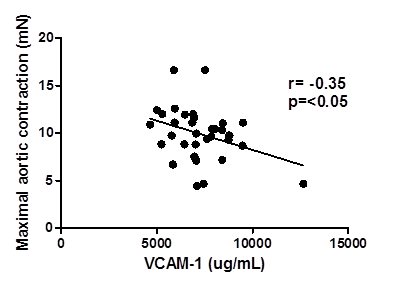Session Information
Session Type: ACR Poster Session B
Session Time: 9:00AM-11:00AM
Background/Purpose:
Mortality
is increased in Rheumatoid arthritis (RA) patients mainly due to cardiovascular
(CV) disease; however the biologic mechanisms are unknown. Increased CV risk in
RA is attributed to both traditional risk factors and systemic
inflammation. CV risk scores, even after modification as recommended by
EULAR, underestimate risk in RA and thus there is a need to develop a better
means of risk stratification. Murine collagen induced arthritis (mCIA) is
associated with vascular dysfunction, characterised by reduced vascular
constriction to 5-hydroxytryptamine (5-HT). This study was undertaken to
characterise the relationship between VCAM-1, which is induced in
proatherosclerotic conditions in the general population, and vascular
dysfunction in mCIA and CV risk in RA patients.
Methods:
mCIA was induced in DBA/1 mice. Severity of arthritis
was assessed by arthritis index score. Constriction responses to 5-HT were used to assess
vascular function in isolated sections of thoracic aorta. Serum VCAM-1 was measured with ELISA.
Serum
VCAM-1, IL-6, ESR and CRP were measured with ELISA in RA patients (182
patients, F:M 4:1, mean age 60 years (range 21-89), mean disease duration 11.4 ±
11 years). CV risk was calculated using the Framingham risk calculator and the QRISK2
algorithm. The latter includes RA as an independent CV risk factor.
Results:
In
mCIA VCAM-1 levels (mean 1500ug/mL, range 929-2528) correlated with arthritis
index score (r=0.43, p=0.03) and negatively correlated with maximal aortic
contraction (r =-0.35, p<0.05) (Figure1).
Figure 1. VCAM-1 is negatively
correlated with maximal aortic contraction in mCIA in DBA-1 mice
In
patients with RA, VCAM-1 was significantly higher in those with a Framingham CV
risk score >10% over 10 years (1200ng/mL ± 547) compared to those
with <10% risk (937ng/mL ± 570, p=0.02). Similarly the respective VCAM-1
levels using the QRISK2 were 1179ng/mL ± 583 versus 949ng/mL ± 564,
p<0.05. VCAM-1 was positively correlated with IL-6 levels (R=0.24, p= 0.008),
DAS28 (r=0.25, p= 0.03) and age (r=0.26, p= 0.002). There was no statistically
significant correlation between VCAM-1 level and disease duration, statin use,
BMI, cholesterol, systolic BP, gender or smoking.
One of the major differences between QRISK2 and
Framingham is inclusion of RA as an independent risk factor in the former. QRISK2
and Framingham CV risk scores were correlated moderately (r=0.7, p<0.0001). Multivariate
analysis using backward stepwise multiple regression, found that VCAM-1 (p=0.002)
was a statistically significant independent predictor of QRISK2 score when
added to Framingham and increased R2 from 0.6 to 0.62.
Conclusion:
VCAM-1 levels correlate not only with disease activity
and vascular dysfunction in mCIA but also disease activity and CV risk in RA.
VCAM-1 is a potential biomarker for CV disease in RA warrants further
investigation.
To cite this abstract in AMA style:
Davies R, Iacono D, Jordan LA, Williams JO, Rawlings C, Lang D, Williams AS, Choy EH. Serum Vascular Cell Adhesion Molecule-1 (VCAM-1) Levels Are Associated with Vascular Dysfunction and Increased Cardiovascular Risk in an Animal Model and Patients with Rheumatoid Arthritis [abstract]. Arthritis Rheumatol. 2015; 67 (suppl 10). https://acrabstracts.org/abstract/serum-vascular-cell-adhesion-molecule-1-vcam-1-levels-are-associated-with-vascular-dysfunction-and-increased-cardiovascular-risk-in-an-animal-model-and-patients-with-rheumatoid-arthritis/. Accessed .« Back to 2015 ACR/ARHP Annual Meeting
ACR Meeting Abstracts - https://acrabstracts.org/abstract/serum-vascular-cell-adhesion-molecule-1-vcam-1-levels-are-associated-with-vascular-dysfunction-and-increased-cardiovascular-risk-in-an-animal-model-and-patients-with-rheumatoid-arthritis/

